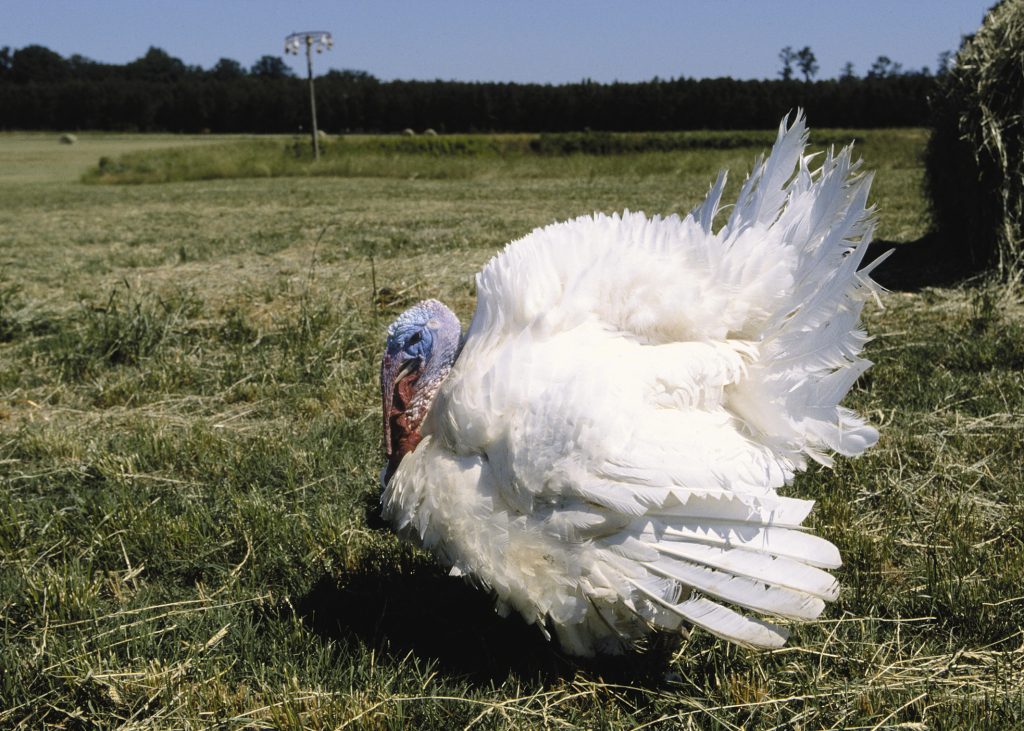Domestic vs. Wild Turkeys
The differences between farm-raised birds and wild turkeys are stark, but they are related.

The turkey is one of the earliest animals domesticated and raised for food in America. Historical writings and artifacts show that Native Americans domesticated turkeys as early as 25 A.D., well before European exploration. Explorers took domesticated turkeys back to Europe from central America in the early 1500s, which started modern farm-raised birds.
There are five subspecies of wild turkey in the U.S.: the Eastern, Rio Grande, Merriam’s, Osceola (Florida) and Gould’s – the Merriam’s and Gould’s are named after the individual who discovered them. They have become different to each other because they are found in different areas and mostly breed only with their same subspecies. In some areas their habitat overlaps, therefore a ‘hybrid’ or cross between the two happens. These ‘hybrids’ display characteristics of both subspecies.
When farmers first started breeding turkeys, they were very similar to their wild turkey counterparts. Unlike in the wild where breeding is random, farmers could pick and choose which turkeys they wanted to keep to breed. They would save the biggest, meatiest birds and after thousands of generations, they have gotten to where we are today.
Among domesticated turkeys, there are also several subspecies which have different characteristics. Some are more resistant to disease or grow quicker, but generally commercially bred turkeys have white plumage. This white coloration is from massive inbreeding that occurred and the small little feathers that remain after processing are harder to see when white.

Farmers wanted bigger and fatter birds producing more meat. Today’s domesticated turkeys are unable to fly due to their size. Farmers have bred the birds to have larger breasts and bigger legs. Their legs are thicker and stockier than their wild cousins.
The commercial farmers raise their turkeys in big barns with enormous fans. You probably have driven past a commercial turkey barn but never noticed what it was. Some hobby farmers raise turkeys to sell on a local scale. Many people prefer these locally raised birds because they are typically raised in better conditions without antibiotics.
Domestic birds are more tender and typically are blander in taste. Wild turkeys have more blood flow in their muscles causing the meat to be darker. The processers of domesticated turkeys often inject the bird before final packaging to add flavor and increase the weight of the bird. A heavier bird brings more money. Because they are so susceptible to disease, you will rarely find a domesticated bird in the wild. The domesticated bird is easy prey for predators considering it cannot fly.
Every year, a few birders and hunters will see a wild turkey that is color-phased or even white. There is a common misconception that this is because they crossbred with a domestic turkey. Although this can be the case, it is not common. Most color-phase wild turkeys are simply due to genetic variations or possibly a mutation no different than any other animal. These birds when found stand out not only to you and I but to predators as well, so they do not often survive long.
Fowl Facts
- Wildlife agencies in the early days tried repopulating the wild turkey with birds raised in pens. They soon found out that did not work because of disease and predators. This is where the cannon net, trapping and relocating wild turkeys started and became the standard for increasing U.S. wild turkey populations. It still happens today, just not at the same scale.
- Domestic turkeys are harvested as early as 12 weeks up to 16 weeks and will weigh between 20 and 35 pounds alive. Wild turkeys at that age are barely 5 pounds.
- Minnesota is the leading producer of domesticated turkeys at around 40 million birds per year, followed by North Carolina at 29 million. Over 75% of American households eat turkey on Thanksgiving, the majority of those being domesticated turkeys.
- If you ever go to the county fair and see turkeys, many will be with color variations. This is because the birds are bred for specific traits not necessarily related to muscle production.
- Domestic turkeys rarely have full beards because they are clipped off by other birds. Since domestic turkeys are raised primarily for their meat and have been overbred they are very susceptible to disease. Farmers will give antibiotics through the turkey’s water supply to help.
